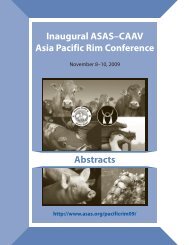2006 Abstracts - American Society of Animal Science
2006 Abstracts - American Society of Animal Science
2006 Abstracts - American Society of Animal Science
Create successful ePaper yourself
Turn your PDF publications into a flip-book with our unique Google optimized e-Paper software.
alive as well as birth weights <strong>of</strong> piglets were recorded immediately afterfarrowing. At d 110 <strong>of</strong> gestation, maternal body weight (P=0.603) andbackfat thickness (P=0.349) did not differ between the control andtreatment groups. The total number <strong>of</strong> pigs born did not differ (P=0.102)between the two groups <strong>of</strong> gilts. However, compared with the controlgroup, arginine supplementation increased the number <strong>of</strong> pigs born aliveby 23% (11.23 vs. 9.12, P=0.029) and litter birth weight by 28% (15.80vs. 12.37 kg, P=0.005). These results demonstrate, for the first time,that dietary L-arginine supplementation improves pregnancy outcomein gilts. Supported by Texas Tech Univ., Texas A&M Univ., Ajinomoto,and USDA/NRI.Key Words: Gestation performance, Gilts, Arginine22 QTL mapping in an F 2 Duroc x Pietrain resource population:II. Carcass and meat quality traits. D. B. Edwards* 1 , C. W.Ernst 1 , N. E. Raney 1 , M. E. Doumit 1 , M. D. Hoge 1,2 , and R. O. Bates 1 ,1 Michigan State University, East Lansing, 2 Western Illinois University,Macomb.Pigs from the F 2 generation <strong>of</strong> a Duroc x Pietrain resource populationwere evaluated to discover quantitative trait loci (QTL) affecting carcasscomposition and meat quality traits. Carcass composition phenotypesincluded primal cut weights, skeletal characteristics, backfat thickness,muscle pH, and carcass temperature. Meat quality data collectedon boneless longissimus muscle chops included objective and subjectivecolor information, marbling and firmness scores, and drip loss. Additionally,chops were analyzed for moisture, protein, and fat compositionas well as cook yield and Warner-Bratzler shear force measurements.Palatability <strong>of</strong> chops was determined by a trained sensory tastepanel. A total <strong>of</strong> 510 F 2 animals were genotyped for 124 microsatellitemarkers evenly spaced across the entire genome. Data were analyzedwith line cross least squares regression interval mapping methods usingsex and litter as fixed effects and carcass weight or harvest age ascovariates. Significance thresholds <strong>of</strong> the F-statistic for additive, dominance,and imprinted QTL were determined on chromosome- and genome-wiselevels by permutation tests. A total <strong>of</strong> 94 QTL for 35 <strong>of</strong> the38 traits analyzed were found to be significant at the 5% chromosomewiselevel. Of these 94 QTL, 16 were significant at the 1% chromosome-wise,13 at the 5% genome-wise, and 14 at the 1% genome-wisesignificance thresholds. Putative QTL were discovered for 45 min pHand pH decline on SSC 3, marbling score and carcass backfat on SSC 6,carcass length and number <strong>of</strong> ribs on SSC 7, marbling score on SSC 12,and color measurements and tenderness score on SSC 15. These resultswill facilitate fine mapping efforts to identify genes controlling carcasscomposition and meat quality traits that can be incorporated into markerassistedselection programs to accelerate genetic improvement in pigpopulations.Key Words: Meat quality, Pigs, Quantitative trait loci23 Differential gene and protein expression in gilt and sowderived oocytes. M. Paczkowski*, D. Terry, C. Bidwell, and R. Krisher,Purdue University, West Lafayette, IN.Gilt derived oocytes matured in vitro demonstrate decreased ability toundergo embryonic development compared to sows, suggesting reducedoocyte competence. Gene transcripts present in oocytes may reflectdevelopmentally important mechanisms. Alternatively, identifying possibleregulatory proteins involved in successful oocyte maturation couldresult in methods to enhance the competence <strong>of</strong> oocytes from prepubertalpigs and increase developmental potential. We hypothesizethat by comparing gene expression and protein complement in oocyteswith high and low developmental potential, we can identify differentiallyexpressed genes that may play a role in mechanisms controllingoocyte competence. Sow and gilt cumulus-oocyte-complexes (COC)were collected from 2 to 6mm follicles and matured for approximately43 h in either defined Purdue Porcine Media (PPMmat), or TCM199medium (supplemented with 10% porcine follicular fluid, 0.5 mM cysteine,0.91 mM pyruvate, and 3.05 mM glucose) for microarray andprotein analysis, respectively. After maturation, COCs were denudedand assessed for maturation, as indicated by polar body extrusion.Dynabead Direct mRNA isolation reagents were used to isolate polyA+ mRNA (n=200 oocytes) for input into the Affymetrix microarraytwo-cycle amplification and labeling system. Two dimensional gel electrophoresiswas performed on oocyte samples (n=3000) and gels werestained with silver nitrate. Protein spots (n=14) were digested withtrypsin and analyzed by mass spec. The results <strong>of</strong> these preliminaryexperiments show that pig oocytes express about 8,800 transcripts(36% <strong>of</strong> the probe sets) that are detectable by the pig AffymetricGeneChip. Differential expression was observed in 292 proteins; 120proteins identified in gilts were absent in sows, while only 55 proteinswere identified in sows that were absent in gilts. Seven proteins wereidentified with high confidence. Differentially expressed genes and proteinswill be further analyzed and their potential roles in developmentalcompetence <strong>of</strong> oocytes investigated.Key Words: Porcine Oocyte, Microarray, Protein Analysis24 Effects <strong>of</strong> L-carnitine and gestation length on growth factormessenger RNA (mRNA) expression in maternal tissues. K. R.Brown* 1 , R. D. Goodband 1 , M. D. Tokach 1 , S. S. Dritz 1 , J. L. Nelssen 1 ,J. E. Minton 1 , D. M. Grieger 1 , J. C. Woodworth 2 , and B. J. Johnson 1 ,1 Kansas State University, Manhattan, 2 Lonza, Inc, Allendale, NJ.Fifty-nine gestating gilts (BW=137.7 kg) were used to determine theeffects <strong>of</strong> dietary L-carnitine on the IGF system expression in maternalreproductive tissues. Treatments were designed as a 2 × 3 factorialarrangement with diet (L-Carnitine or control) and gestation day (40,55, or 70) as main effects. Gilts were fed a gestation diet once daily (1.75kg) with a 50-g top dress containing either 0 (n=30) or 88 mg (50 ppm)<strong>of</strong> L-carnitine (n=29) from breeding through d 40, 55, or 70 <strong>of</strong> gestationwhen maternal reproductive tissues were collected. Real-time quantitativePCR was used to measure growth factor messenger RNA (mRNA)levels in uterine, myometrial, and endometrial tissues. There were nointeractions between diet and gestation day. Supplementing gilts withL-carnitine increased endometrial IGFBP-3 (P=0.05) and IGFBP-5(P=0.01) mRNA abundance, and numerically increased IGF-I (P=0.16;4.52 vs. 3.34). Endometrial IGF-I, IGF-II, IGFBP-3, and IGFBP-5mRNA levels were not different among gestation lengths. Carnitine didnot influence myometrial or placental IGF-I, IGF-II, IGFBP-3, andIGFBP-5 mRNA abundance. As gestation increased from d 40 to 55,IGF-I, IGFBP-3, and IGFBP-5 mRNA abundance decreased (P
















